Pattern 1939 Leather Infantry Equipment
Pouches, Basic and Utility
In addition to the Hose Rivets used throughout the Pattern, stitching was employed only to secure the fibre linings to the edges of the leather parts.
Pouch basic, left, 1st Issue
Pouch, basic, right, 1st Issue

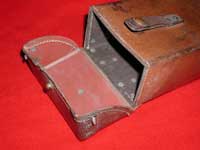 A good case could be made for terming these Ammunition cases, the envelopes being rigid boxes. A single piece of leather, laminated and stitched to a fibreboard backing, was formed into the four sides and base, the junction being a fold around the outer side and hose-rivetted over its full length. An extension of the rear wall was folded forward and its three sides turned up into a tray form, which was then riveted into place. The box-lid, similarly laminated and stitched to a fibre liner, was also formed in one piece, the assembly then being rivetted to the upper rear edge of the leather box now formed. A fairlead, tapered to the webbing shape, had its narrow end turned rearwards around a 4-bar buckle and riveted. This assembly was riveted to the upper rear face, providing a “tunnel”, as with Patt. ’37, for the Brace end to be passed behind the Pouch. The example at left is a right-hand Pouch from the Tom Ready Collection. The interior view shows the fibreboard lining. Photos © Tom Ready 2010.
A good case could be made for terming these Ammunition cases, the envelopes being rigid boxes. A single piece of leather, laminated and stitched to a fibreboard backing, was formed into the four sides and base, the junction being a fold around the outer side and hose-rivetted over its full length. An extension of the rear wall was folded forward and its three sides turned up into a tray form, which was then riveted into place. The box-lid, similarly laminated and stitched to a fibre liner, was also formed in one piece, the assembly then being rivetted to the upper rear edge of the leather box now formed. A fairlead, tapered to the webbing shape, had its narrow end turned rearwards around a 4-bar buckle and riveted. This assembly was riveted to the upper rear face, providing a “tunnel”, as with Patt. ’37, for the Brace end to be passed behind the Pouch. The example at left is a right-hand Pouch from the Tom Ready Collection. The interior view shows the fibreboard lining. Photos © Tom Ready 2010.
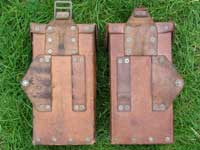
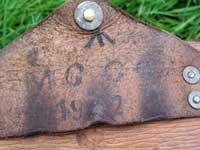 Thus far the Pouches were identical, but the belt loops then made them “handed”. In the 1st Issue, the double belt loops were each different: the outermost was extended into a triangular tab, with a Steadying Hook riveted to the point. As it was visible, the chromed side had to face the front, leaving one loop as “flesh side”. The hook pointed forwards, into the side of the Pouch and served to secure the Pouch location, using the belt adjustment holes, in exactly the same way as a Sam Browne Pistol case. The second loop, in 1-inch leather was nearest the belt buckle and was chromed side outwards, giving a mismatched appearance to the loops. This pair are maker marked "MG CO." and dated 1942. Photos courtesy of War Department Militaria, © Paul Laidlaw 2010.
Thus far the Pouches were identical, but the belt loops then made them “handed”. In the 1st Issue, the double belt loops were each different: the outermost was extended into a triangular tab, with a Steadying Hook riveted to the point. As it was visible, the chromed side had to face the front, leaving one loop as “flesh side”. The hook pointed forwards, into the side of the Pouch and served to secure the Pouch location, using the belt adjustment holes, in exactly the same way as a Sam Browne Pistol case. The second loop, in 1-inch leather was nearest the belt buckle and was chromed side outwards, giving a mismatched appearance to the loops. This pair are maker marked "MG CO." and dated 1942. Photos courtesy of War Department Militaria, © Paul Laidlaw 2010.
Pouch, basic, 1st Issue (hook tab removed)
Pouch, basic, leather, pattern ’39
 The second nomenclature is official, coming from the 1942 Home Guard equipment scale. Judged by the number of examples, this arrangement was officially modified, such that the two belt loops were made identical. Handed items are all very well, but they bring supply problems – enough of one side, but not the other. They also require more process time to make them different. In wartime, you do not want to waste production effort, though the evidence is lacking that these became the new production standard. Consequently the Pouches were un-handed, for issuing purposes only, by cutting off the Steadying Hook extension. This is always obvious, as the modified loop is still “flesh side” out, the example here formerly being a right hand Pouch. This example is maker marked "MG CO." and dated 1942. From the Tom Ready Collection. Photo © Tom Ready, 2010.
The second nomenclature is official, coming from the 1942 Home Guard equipment scale. Judged by the number of examples, this arrangement was officially modified, such that the two belt loops were made identical. Handed items are all very well, but they bring supply problems – enough of one side, but not the other. They also require more process time to make them different. In wartime, you do not want to waste production effort, though the evidence is lacking that these became the new production standard. Consequently the Pouches were un-handed, for issuing purposes only, by cutting off the Steadying Hook extension. This is always obvious, as the modified loop is still “flesh side” out, the example here formerly being a right hand Pouch. This example is maker marked "MG CO." and dated 1942. From the Tom Ready Collection. Photo © Tom Ready, 2010.
Pouch, basic, leather, pattern ’39 (modified)
 Like the Cartridge carrier, this is an official nomenclature, taken off a Home Guard Scale of 1942. It is unfortunate that its format does not quite match that of the Cartridge carrier, though it uses the same words! It is also un-tidy that “pattern” was rendered all in lower case. Since it specifically mentioned Home Guards armed with the Sten S.M.C., it follows this must be the version with the closure tab re-located. With the War Office having claimed “modified”, the same word cannot be used for those with the Steadying Hook tabs cut off. The example at left has had the hook tabs removed.
Like the Cartridge carrier, this is an official nomenclature, taken off a Home Guard Scale of 1942. It is unfortunate that its format does not quite match that of the Cartridge carrier, though it uses the same words! It is also un-tidy that “pattern” was rendered all in lower case. Since it specifically mentioned Home Guards armed with the Sten S.M.C., it follows this must be the version with the closure tab re-located. With the War Office having claimed “modified”, the same word cannot be used for those with the Steadying Hook tabs cut off. The example at left has had the hook tabs removed.
It is self-evidently an official modification, though no documentation has yet surfaced. It entailed removing the two rivets holding the press fastener tab. A new hole was punched, at the same pitch distance, but above the original upper hole. The press fastener tab was re-rivetted in the upper holes, leaving a visible un-used hole below the tab. This modification allowed Sten S.M.C. magazines to be carried, so corresponds to the Mark III Patt. ’37 Basic pouch, which accommodated these magazines by being made ½-inch taller. This example is maker marked "MG CO." and dated 1942. From the Tom Ready Collection. Photo © Tom Ready, 2010.
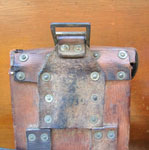 As several of our readers have pointed out since this entry was originally written, the paragraph above is not quite complete and correct. Not just the fastener tab was relocated - another piece of leather was added at the rear and the entire box lid was raised to accomodate the greater length of the Sten magazines. The example at right is from the Mel Dundas-Taylor Collection, photograph © Mel Dundas-Taylor 2012.
As several of our readers have pointed out since this entry was originally written, the paragraph above is not quite complete and correct. Not just the fastener tab was relocated - another piece of leather was added at the rear and the entire box lid was raised to accomodate the greater length of the Sten magazines. The example at right is from the Mel Dundas-Taylor Collection, photograph © Mel Dundas-Taylor 2012.
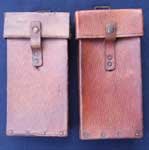
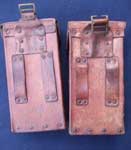
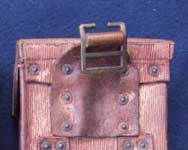 A manufacturing variation of the Pouch, basic, leather. The extension hinge for the top cover is stitched and rivetted, instead of simply rivetting as is usually seen (compare with the example show just above). The ACI for modified Cartridge Carriers (to cope with U.S. .300 ammunition) makes it explicit that the mod was to be done at unit level. KW therefore interpret this as one unit's version of adding the extension hinge. Perhaps stitching the hinge on the lid was simpler, as it was more accessible? Then riveting this new assembly to the body, because stitching might've been more "confined" inside the body...? Perhaps they'd miscalculated the rivet indent...?! The examples shown here are from the Martin Clewlow Collection, photograph © Martin Clewlow 2016.
A manufacturing variation of the Pouch, basic, leather. The extension hinge for the top cover is stitched and rivetted, instead of simply rivetting as is usually seen (compare with the example show just above). The ACI for modified Cartridge Carriers (to cope with U.S. .300 ammunition) makes it explicit that the mod was to be done at unit level. KW therefore interpret this as one unit's version of adding the extension hinge. Perhaps stitching the hinge on the lid was simpler, as it was more accessible? Then riveting this new assembly to the body, because stitching might've been more "confined" inside the body...? Perhaps they'd miscalculated the rivet indent...?! The examples shown here are from the Martin Clewlow Collection, photograph © Martin Clewlow 2016.
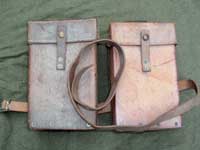 Illustrated on the left of this group, these were constructed as the Basic pouches, described above, but made larger. Whilst these replicated the envelope of the webbing item, it can at last be confirmed that there were the two forms – front and rear – of the webbing Pouches. All examples, previously noted, only had a strap fairlead. The (incorrect, as it turned out) assumption was therefore that there was a separate waist strap, fastened with a Buckle, brass, 1-in. Photo courtesy of War Department Militaria, © Paul Laidlaw 2010.
Illustrated on the left of this group, these were constructed as the Basic pouches, described above, but made larger. Whilst these replicated the envelope of the webbing item, it can at last be confirmed that there were the two forms – front and rear – of the webbing Pouches. All examples, previously noted, only had a strap fairlead. The (incorrect, as it turned out) assumption was therefore that there was a separate waist strap, fastened with a Buckle, brass, 1-in. Photo courtesy of War Department Militaria, © Paul Laidlaw 2010.
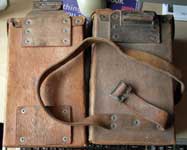 Chris Pollendine has the honour of the first Front pouch I had seen, followed by Paul Laidlaw’s example. This at last showed that the many other examples, with just a fairlead, were all Rear pouches. Another difference was the use of 2-inch buckles for the Yoke, in place of the 1 1/2-inch buckles on the web versions. It is perhaps only coincidental that the Brace for Lewis magazine pouches was compatible. As the Bren had supplanted the Lewis, as the standard L.M.G. for both Regular and Territorial Armies, there must therefore have been surplus web Yokes. Photo © Chris Pollendine, from the Chris Pollendine Collection.
Chris Pollendine has the honour of the first Front pouch I had seen, followed by Paul Laidlaw’s example. This at last showed that the many other examples, with just a fairlead, were all Rear pouches. Another difference was the use of 2-inch buckles for the Yoke, in place of the 1 1/2-inch buckles on the web versions. It is perhaps only coincidental that the Brace for Lewis magazine pouches was compatible. As the Bren had supplanted the Lewis, as the standard L.M.G. for both Regular and Territorial Armies, there must therefore have been surplus web Yokes. Photo © Chris Pollendine, from the Chris Pollendine Collection.
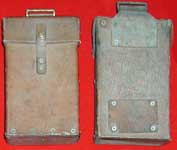 It is a coincidence that the paired Pouches can be linked with the Brace, pouch, Lewis gun, web used to link pairs of Pouches, Magazine, Lewis gun, web. The Patt. ’39 Pouches used the 3-bar Buckle, brass, 2 inch, the Lewis pouches used a 4-bar buckle, which seems never to have been given a discrete nomenclature. Chris Pollendine’s three piece Belt confirms that leather Yokes were used. These examples, showing front and rear views, are from the Tom Ready Collection. © Tom Ready 2010.
It is a coincidence that the paired Pouches can be linked with the Brace, pouch, Lewis gun, web used to link pairs of Pouches, Magazine, Lewis gun, web. The Patt. ’39 Pouches used the 3-bar Buckle, brass, 2 inch, the Lewis pouches used a 4-bar buckle, which seems never to have been given a discrete nomenclature. Chris Pollendine’s three piece Belt confirms that leather Yokes were used. These examples, showing front and rear views, are from the Tom Ready Collection. © Tom Ready 2010.
Rog Dennis, December, 2010